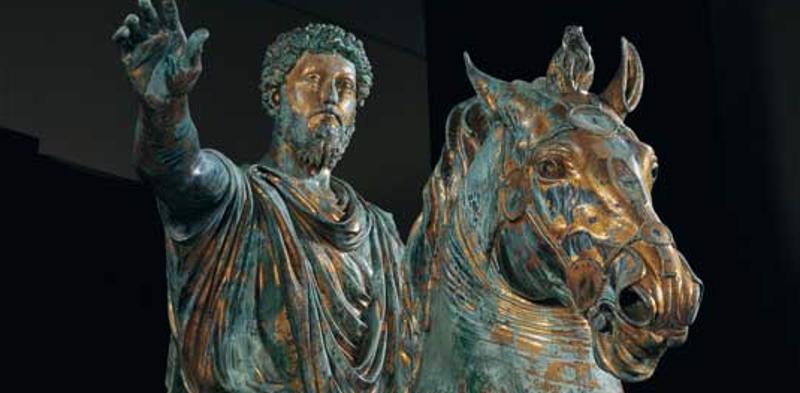My diary
http://en.museicapitolini.org/collezioni/percorsi_per_sale/museo_del_palazzo_dei_conservatori/esedra_di_marco_aurelio/statua_equestre_di_marco_aurelio
The Equestrian Sculpture of Marcus Aurelius reveals that at the time the Romans valued Constantine more than Marcus Aurelius because they believed that this sculpture was actually Constantine. This cultural landscape tells a story of how Marcus Aurelius died. When an equestrian sculpture is created with all four of the hooves of the horses on the ground, it means that the rider died in a natural way. When only two of the horse’s hooves are on the ground, it reveals that the rider died in battle. However, in this sculpture only 3 of the hooves are on the ground and only one hoof is in the air signifying
kmullen1
22 chapters
16 Apr 2020
Rome 2017: (6) The Equestrian Sculpture of Marcus Aurelius
January 08, 2017
http://en.museicapitolini.org/collezioni/percorsi_per_sale/museo_del_palazzo_dei_conservatori/esedra_di_marco_aurelio/statua_equestre_di_marco_aurelio
The Equestrian Sculpture of Marcus Aurelius reveals that at the time the Romans valued Constantine more than Marcus Aurelius because they believed that this sculpture was actually Constantine. This cultural landscape tells a story of how Marcus Aurelius died. When an equestrian sculpture is created with all four of the hooves of the horses on the ground, it means that the rider died in a natural way. When only two of the horse’s hooves are on the ground, it reveals that the rider died in battle. However, in this sculpture only 3 of the hooves are on the ground and only one hoof is in the air signifying

the rider was injured in battle and then died subsequently. This cultural landscape adequately displays how Marcus Aurelius died. It is also interesting to realize the value that was placed upon this equestrian sculpture, this is shown by the multiple other sculptures that were created by copying this sculpture. This cultural landscape also reveals the value that Romans placed on their leaders who died while fighting for the Republic. The Romans did value battle and knew that in battle is when they preserve the Republic.
1.
Rome 2017: Overview
2.
Rome 2017: (1) The Colomn of Trajan
3.
Rome 2017: (2) The Capitoline Wolf and The Twins
4.
Rome 2017: (3) The Alter of Peace (Ara Pacis)
5.
Rome 2017: (4) The House Of Vestal Virgins
6.
Rome 2017: (5) The Bust of Constantine
7.
Rome 2017: (6) The Equestrian Sculpture of Marcus Aurelius
8.
Rome 2017: (7) The Miliarium Aureum
9.
Rome 2017: (8) The Dying Gaul
10.
Rome 2017: (9) The Head of Lucius Junius Brutus
11.
Rome 2017: (10) The Boxer at Rest
12.
Rome 2017: (11) Augustus of Prima Porta
13.
Rome 2017: (12) Saint Paul's Statue
14.
Rome 2017: (13) Moses
15.
Rome 2017: (14) Santa Sabina
16.
Rome 2017: (15) The Holy Stairs
17.
Rome 2017: (16) The School of Athen's
18.
Rome 2017: (17) Disputation over the Holy Sacrament
19.
Rome 2017: (18) Saint John’s Lateran
20.
Rome 2017: (19) Danae
21.
Rome 2017: (20) Victor Emmanuel II
22.
Rome 2017: Conclusion
Share your travel adventures like this!
Create your own travel blog in one step
Share with friends and family to follow your journey
Easy set up, no technical knowledge needed and unlimited storage!